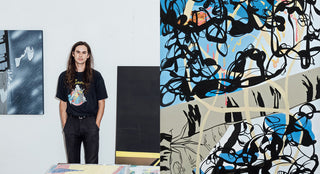Cartoons and erotica have much in common—fantasy, desire, an adipose sense of volume. Aaron Elvis Jupin assembles these polarities of play and smut, refracting their constituent parts to form a visual cosmology that crawls over paintings, onto walls, into various vintage ephemera. The results layer innuendo and innocence; a declension of glyphs sticking their tongue out at the fuddy duddiness of words.
His plays with animation references lack deference even to the wild physics of cartoons. His images stop just short of cohering into a picture, drawing parallels closer to dream logic and the lacunae of memory. As Jupin moved away from his early work, daubing on vintage girly mags with escapist titles like Escapade and Magic Touch, his paintings took on more of themselves. They are highly redolent, but ultimately self-referential. Shadows, colors, and lines swell and contract—at once kitschy and academic, redolent and abstract.
A painting in the corner of a shed takes cues from the bleakest parts of beloved childhood classics—the storm scene from Bambi, Dumbo being separated from his mother—but stripped of recognizable elements; there is something universal in its depiction of turmoil. You can read it without knowing jack about Bambi or Dumbo.
We chatted over iced coffee in his Boyle Heights studio, on cartoons and Catholic school, cultural consciousness, and viewing art through a socioeconomic lens.
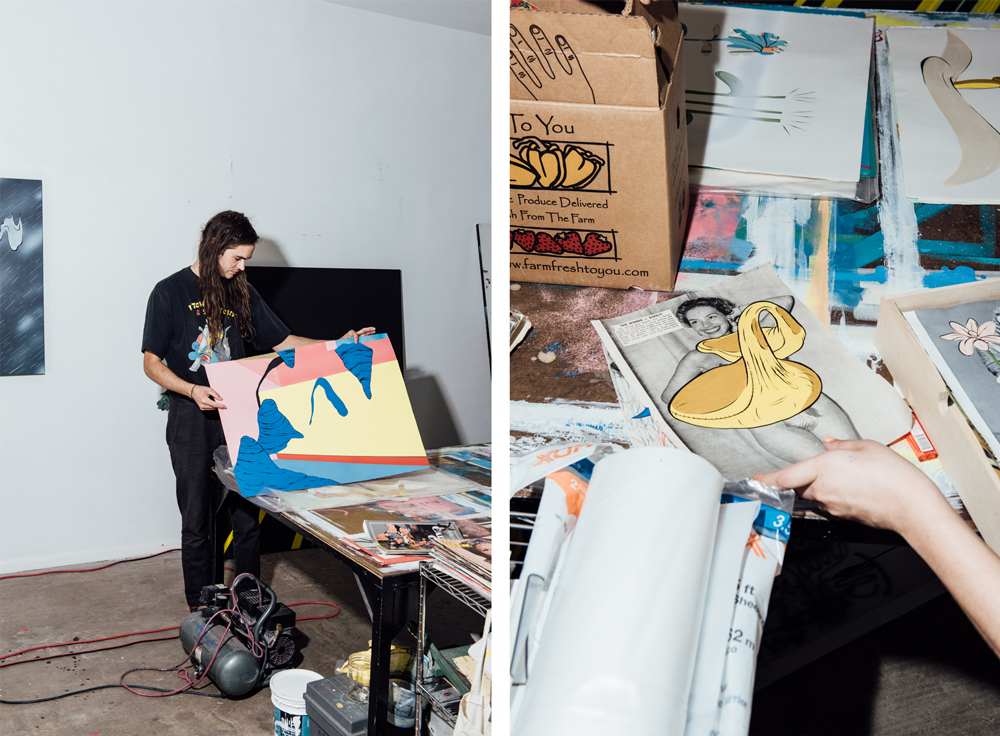
CHRISTINA CATHERINE MARTINEZ: Does your work always refer to specific stories/cartoons? It’s hard to tell.
AARON ELVIS JUPIN: As personal as I try to make the paintings, I’m distancing myself from the work at the same time. I’m taking my hand out of the work but then putting it back in. So much of early animation is about the hand, but it’s so repetitive it diminishes the hand, too. It’s not The Artist’s Hand. It’s the hand writ large.
The abstract idea of the hand in service of a visual language, and no one really has authorship over that.
Yeah, nobody owns thick to thin—meaning the line quality! We look across scattered paintings, some extremely sparse, with just a few elements—a table leg, a pushed up corner of rug—floating on the white plane.
So much of painting is just knowing when to stop. The paintings kind of mix this idea of the anonymous hand of animation. That thick-thin line is still there, along with painterly elements that are definitely the hand of an individual.
Actually, a lot of the more painterly-looking elements are airbrushing, which is another kind of anonymous hand technique. Anyone can learn to airbrush, you know? And I’ve discovered a lot of painters airbrushing right now. When I first saw that I thought, I’ve been airbrushing since I was a freshman in high school! I sold airbrushed T-shirts to kids. I never thought it was art. And now it’s in the art world proper. I had no idea.

Bug’s Horse
Art has a way of appropriating vernacular techniques and, doubling back on itself, taking things in the world for itself.
The art world is such a weird place, but it has fads and trends like any other part of culture. I’ll go to art fairs and suddenly one year everything is printed on lenticular. At Art LA (Contemporary) this year I think I counted nine booths with all lenticular prints.
“As a kid, I went to Catholic school and never went to museums or galleries… Then I would go home and watch cartoons. This was my earliest exposure to ‘art.'”
And we grew up thinking lenticulars were toys! I do like this idea of fine artists using airbrushing or animation technique, which are styles associated with being, I don’t know, working class? Because they are concrete skills with commercial applications? But you combine them in a way that echoes academic paintings, or studies.
It’s funny that you say working class. As a kid, I went to Catholic school and never went to museums or galleries or anything like that. We didn’t do those kinds of field trips; there was no art class. We made stations of the cross illustrations, or put on a play about Jesus. Then I would go home and watch cartoons. This is was my earliest exposure to “art.” And I lived right by Disneyland. Going to Disneyland was like going to an art museum for me. All of this stuff is real, it’s designed, it’s fabricated—I was obsessed with going to Disneyland as a kid.
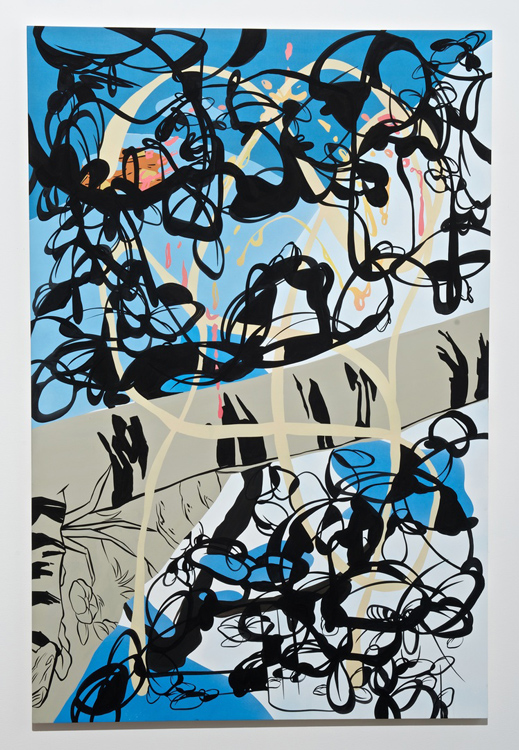
Bloom
But you did go to art school, eventually.
Yes, after high school. I was exposed to the art world for the first time and I felt so out of place. I had no knowledge up until that point. I didn’t know who the major artists were. I remember seeing that Beautiful Losers exhibit curated by Aaron Rose and it blew my mind. I was making stencils and shooting black and white photos. I was a skater. That’s what I did. Then I went to art school and met people who could draw a nude. That kind of life-drawing, rendering, painting drapes and fruit or whatever, was just not something I did before going to art school. The first time I took a life-drawing class I realized, here I am in front of this naked lady and I have to draw her and I have no idea how to draw. I came into it with a completely different conception of what a drawing to a painting even is.
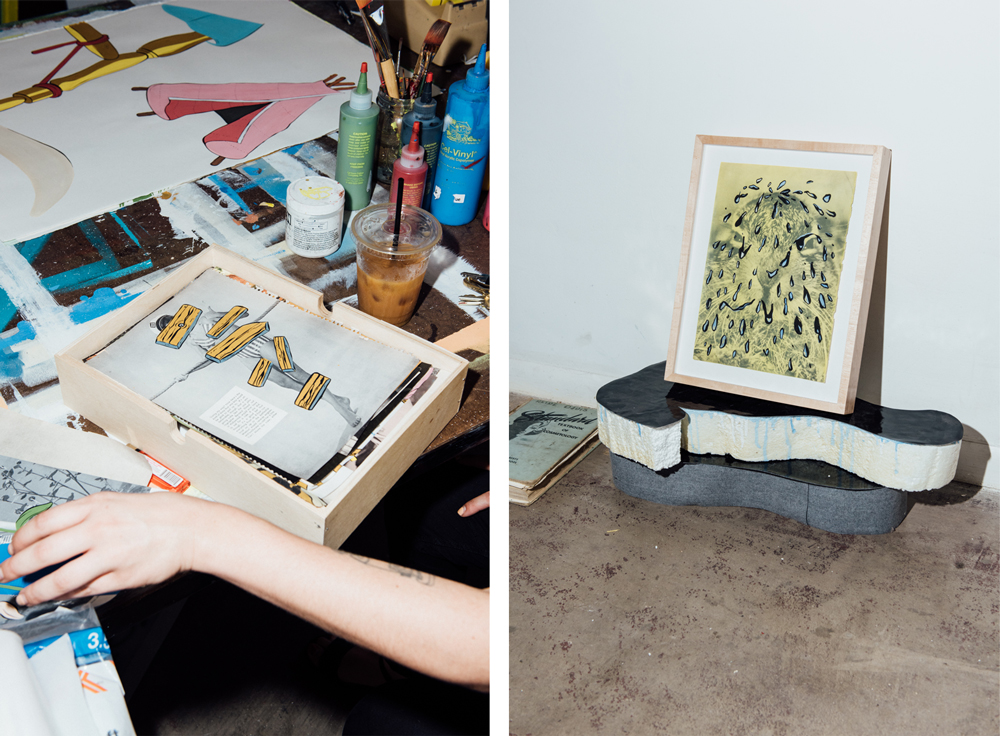
“What I learned in school is to trust my own frame of reference.”
But that goes both ways. Someone who grew up going to galleries or looking at “real” art wouldn’t think to use airbrushing in this context, and what that might mean. Your paintings are almost parodies of painting studies.
What I learned in school is to trust my own frame of reference. For a while I was trying to make paintings that I just couldn’t make. I can’t paint the fucking bubble. I was trying to be realistic, or painterly, but really I was into a lot of lowbrow stuff. I loved Shag and Tim Biskup and Anthony Ausgang. Those guys are what excited me. And learning to marry that to everything else I was learning about art history.
You become aware of how cultural consciousness, especially during formative years, can be tied to class or socioeconomic status.
For sure.
Then you go to art school and broaden your horizons… but those roots are still a part of you.
And if you’re not reflecting on that, or you pretend it was never a part of you, what are you really making?
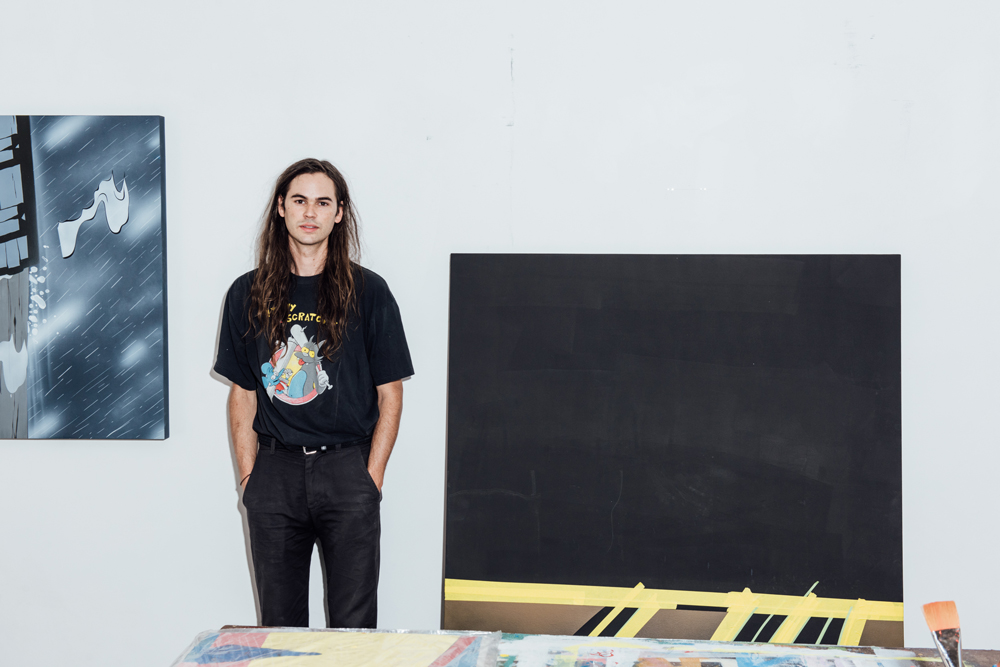
***
aaronelvisjupin.com. Follow Aaron Elvis Jupin on Instagram @jupescoops.
Aaron is currently in a group show called HEAT at Paul Loya Gallery (2677 S La Cienega Blvd) through August 21, along with artists Sterling Bartlett, Ryan Schaeffer, Kingsley Ifill, James Ulmer, Brian Montuori, and Chas Shroeder.
Photos by Graham Walzer.

